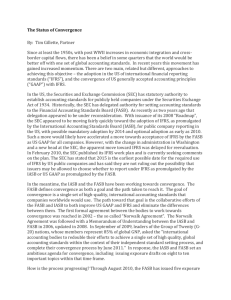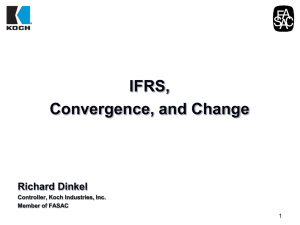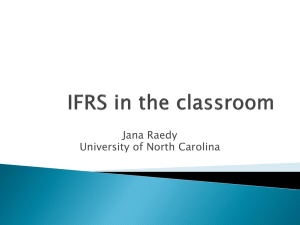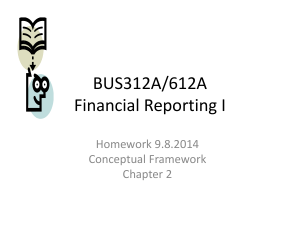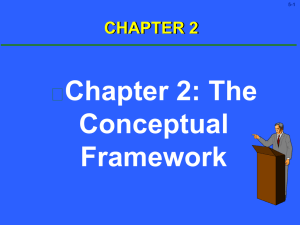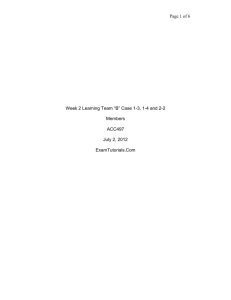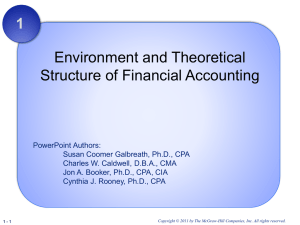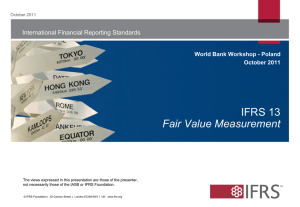Fair Value Measurement - Financial Accounting Standards
advertisement
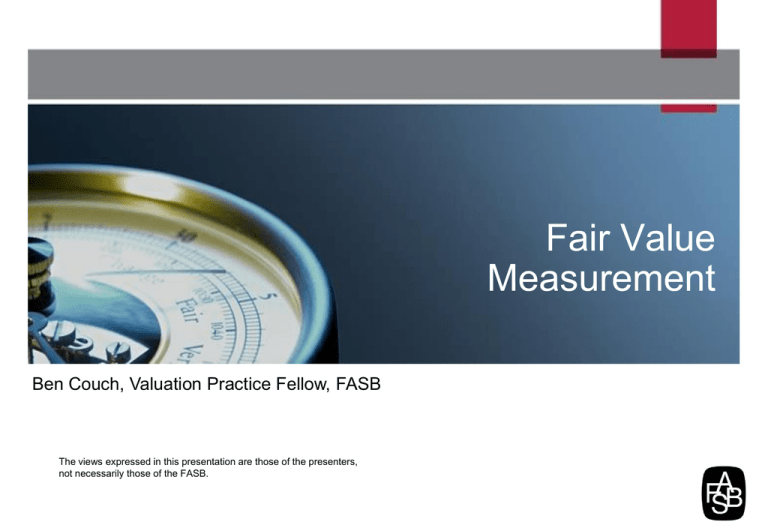
Fair Value Measurement Ben Couch, Valuation Practice Fellow, FASB The views expressed in this presentation are those of the presenters, not necessarily those of the FASB. Agenda • Project timeline and background • Fair value measurement overview • Disclosure • Application to nonpublic entities • Effective date and transition 2 Project Timeline 2003 2004 2005 2006 Jun 2003 Jun 2004 Sep 2005 Sep 2006 FVM project added to FASB’s agenda FASB exposure draft published FVM project added to IASB’s agenda FASB issued SFAS 157 Sep 2004 FASB round table meetings Nov 2006 IASB discussion paper published (using SFAS 157 as starting point) 2007 Project Timeline continued 2008 2009 2010 2011 Oct 2008 May 2009 Jun 2010 May 2011 IASB Expert Advisory Panel report FASB FSP FAS 157-4 published FASB exposure draft published Measuring and disclosing the fair value of financial instruments in markets that are no longer active Determining Fair Value When the Volume and Level of Activity for the Asset or Liability Have Significantly Decreased and Identifying Transactions That Are Not Orderly Amendments for Common Fair Value Measurement and Disclosure Requirements in U.S. GAAP and IFRSs Common IFRS and U.S. GAAP fair value measurement standards FASB FSP FAS 157-3 published Determining the Fair Value of a Financial Asset when the Market for that Asset is Not Active May 2009 IASB Exposure draft published Fair Value Measurement Nov-Dec 2009 IASB Round table meetings IASB exposure draft published Measurement Uncertainty Analysis Disclosure for Fair Value Measurements ASU No. 2011-04 IFRS 13 H2 2011 IFRS Foundation educational material Consistent fair value measurements IFRSs US GAAP Fair value measurement guidance in various standards May 2009 exposure draft Fair Value Measurement Topic 820 (codified SFAS 157) Objective: Common (identical) fair value measurement and disclosure standards 5 Fair Value Measurement Overview Main changes in U.S. GAAP Topic Resolution Premiums and discounts Premiums and discounts relevant to market participants for the unit of account may be used if Level 1 inputs unavailable. No block discounts (entity-specific, unit of account issues). Fair value for financial instruments with offsetting risks Financial instruments can be valued on a net basis. Fair value of instruments classified in shareholders’ equity Requirement to value from the perspective of a market participant holding instrument as an asset. Disclosures • • • • • Quantitative inputs for Level 3 Narrative sensitivity analysis Valuation processes Current use if different from highest and best use Level in fair value hierarchy for fair value measurements disclosed but not reported • All transfers into/out of Levels 1 and 2 Fair Value Measurement Overview continued Differences between Topic 820 and IFRS 13 Topic Reason for difference NAV practical expedient Different accounting for investment companies in local country GAAP means IASB cannot yet allow a practical expedient. Deposit liabilities Different requirements in IFRS and US GAAP for measuring fair value of deposit liabilities • IFRS 13 contains measurement guidance • Topics 825 and 942 contain measurement guidance Disclosures • IFRS does not allow net presentation of derivatives • IFRS requires quantitative sensitivity analysis for financial instruments • In IFRS nonpublic entities are covered by SME standard Premiums and Discounts • Must be consistent with characteristics of asset or liability and the unit of account – No block discounts Is a Level 1 input available? Available Not available Market Would market participants incorporate premium or discount in transaction? Does fair value include premium or discount? n/a FV = Level 1 price x quantity held Yes Yes No No participants act in their economic best interest in a transaction for the unit of account. Financial Instruments • Exception for financial assets and liabilities with offsetting positions in market risk or counterparty credit risk – Entity must have documented risk management strategy – Only for portfolios of instruments measured at FV – Accounting policy decision Financial Instruments continued • Market risks: – Must be substantially the same – Duration of instruments leading to exposure to market risk must be substantially the same • Counterparty credit risk: – Must have arrangement to mitigate credit risk in place Liabilities and Shareholders’ Equity Is there an observable market price to transfer the instrument? Yes Fair value = observable market price of instrument Does somebody hold the corresponding asset? Yes Fair value = observable market price of asset Yes No Fair value = another valuation technique No Fair value = fair value of the corresponding asset Is there an observable market price for the instrument traded as an asset? No Fair value = another valuation technique Disclosure • More information required for Level 3 fair value measurements: – A quantitative disclosure of the unobservable inputs and assumptions used in the measurement – A description of the valuation control process in place – A discussion of the sensitivity of the fair value to changes in unobservable inputs and any interrelationships between those inputs that magnify or mitigate the effect on the measurement Disclosure continued • Example Quantitative information about fair value measurements using significant unobservable inputs (Level 3) ($ in millions) Description Equity securities: Healthcare industry Fair value at 12/31/X9 53 Valuation technique(s) Discounted cash flow Market comparable companies Unobservable input weighted average cost of capital long-term revenue growth rate long-term pre-tax operating margin discount for lack of marketability control premium EBITDA multiple revenue multiple discount for lack of marketability control premium Range (weighted average) 7% - 16% (12.1%) 2% - 5% (4.2%) 3% - 20% (10.3%) 5% - 20% (17%) 10% - 30% (20%) 10 - 13 (11.3) 1.5 - 2.0 (1.7) 5% - 20% (17%) 10% - 30% (20%) Disclosure continued • Current use of a nonfinancial asset when it differs from the highest and best use considered in its fair value measurement and reasons why – Required whether fair value is recognized or only disclosed • All transfers between Level 1 and Level 2 of the fair value hierarchy (no significance threshold) Disclosure continued • For fair value measurements that are only disclosed, the level in which the fair value measurement would be categorized within the fair value hierarchy – Other disclosure requirements for fair value measurements would not apply Application of Topic 820 to Nonpublic Entities • Measurement principles apply equally to public and nonpublic entities, but some disclosures not required for nonpublic entities – Transfers between Level 1 and Level 2 – Sensitivity of Level 3 fair value measurements to changes in unobservable inputs – Level in which a fair value measurement would be categorized within the fair value hierarchy when asset or liability not measured at fair value in statement of financial position, but disclosure of fair value is required Effective Dates and Transition 2011 2012 2013 May 2011 January 1, 2013 Common IFRS and U.S. GAAP fair value measurement standards IFRS 13 effective ASU No. 2011-04 IFRS 13 December 15, 2011 ASU No. 2011-04 effective Public entities • Interim and annual periods • Prospective transition with disclosure of changes and quantitative effect • Early application not permitted Nonpublic entities • Annual periods • Prospective transition with disclosure of changes and quantitative effect • Early application permitted for interim periods after December 15 Prospective transition Early application permitted Q&A Expressions of individual views by members of the FASB and its staff are encouraged. The views expressed in this presentation are those of the presenter. Official positions of the FASB on accounting matters are determined only after extensive due process and deliberation.

